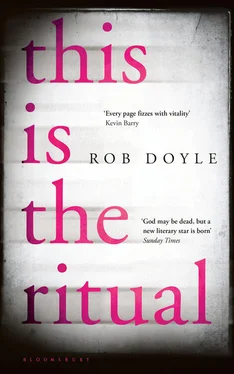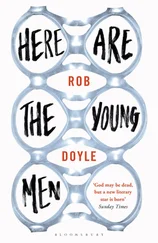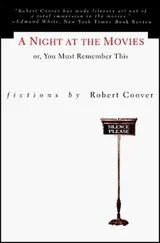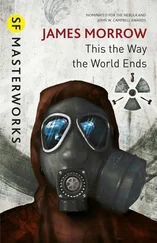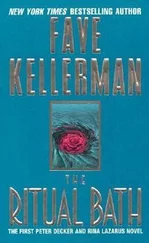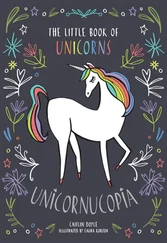Rob Doyle - This is the Ritual
Здесь есть возможность читать онлайн «Rob Doyle - This is the Ritual» весь текст электронной книги совершенно бесплатно (целиком полную версию без сокращений). В некоторых случаях можно слушать аудио, скачать через торрент в формате fb2 и присутствует краткое содержание. Год выпуска: 2016, Издательство: Bloomsbury Publishing, Жанр: Современная проза, на английском языке. Описание произведения, (предисловие) а так же отзывы посетителей доступны на портале библиотеки ЛибКат.
- Название:This is the Ritual
- Автор:
- Издательство:Bloomsbury Publishing
- Жанр:
- Год:2016
- ISBN:нет данных
- Рейтинг книги:5 / 5. Голосов: 1
-
Избранное:Добавить в избранное
- Отзывы:
-
Ваша оценка:
- 100
- 1
- 2
- 3
- 4
- 5
This is the Ritual: краткое содержание, описание и аннотация
Предлагаем к чтению аннотацию, описание, краткое содержание или предисловие (зависит от того, что написал сам автор книги «This is the Ritual»). Если вы не нашли необходимую информацию о книге — напишите в комментариях, мы постараемся отыскать её.
This is the Ritual — читать онлайн бесплатно полную книгу (весь текст) целиком
Ниже представлен текст книги, разбитый по страницам. Система сохранения места последней прочитанной страницы, позволяет с удобством читать онлайн бесплатно книгу «This is the Ritual», без необходимости каждый раз заново искать на чём Вы остановились. Поставьте закладку, и сможете в любой момент перейти на страницу, на которой закончили чтение.
Интервал:
Закладка:
‘I see you,’ whispers Mitchelmore one night, drunk, peering out the window of the high-rise flat where he has lived since his divorce eight years ago. ‘I know you, I feel you. I. . taste you.’
To the concern of his senior officers, and of Nancy, the social worker with whom he has become romantically involved, Mitchelmore loses interest in anything outside of the football-fan murders. His relationship with Nancy falls apart — Mitchelmore hardly seems to notice. He no longer drinks in his local. He takes to sleeping at his desk, waking with a start to find himself peering at an assemblage of photographs: the victims’ wounds; the locations of their deaths; the crowds outside the Ibrox and Parkhead on match days; derelict flats and dank, gloomy hallways with no obvious link to the case. Mitchelmore starts drinking in the inner-city pubs once frequented by the victims, concealing his loyalty when in Rangers pubs (he is a Celtic supporter), saying little, watching, waiting (but waiting for what? Even he seems not to know).
His sergeant, Duncan Shearer, suspends Mitchelmore. ‘You’re losing it, Jake,’ he rasps. ‘Get a grip, before there’s no way back.’ Needless to say, Mitchelmore pays little heed and continues his obsessive investigation. One more murder is committed which may or may not be connected to the others: a Rangers fan is stabbed outside a chipper near the Ibrox. Mitchelmore is certain that this is the next killing in the series. By now, the reader has ample reason to doubt Mitchelmore’s judgement, indeed his participation in a shared reality. Winter sets in. Mitchelmore, no longer in contact with friends, family or former colleagues, drinks more heavily. He gets into fights. A whore wanks him off down a lane but he is too drunk to come. He throws up. He collapses. Owed rent, his landlord appears at Mitchelmore’s flat and finds he has not been sleeping there with any regularity. The muted roar of inner-city Glasgow closes in over Mitchelmore. Christmas arrives. The city is cold, and silent but for the wind blowing through the lanes, past shuttered-up pubs and factories. A child cries in the distance. A dog whimpers and gnaws on its own leg. Here the novel ends.
After Mitchelmore , Malcolm Donnelly abandoned Glasgow as a fictional setting. His subsequent novels, Queen of the Narcos and Jazz Vendetta , published after four- and five-year intervals respectively, were set in Harlem, Peru and Nigeria, and saw a return to the fantastical storylines and buoyant mood of Donnelly’s earlier work. He died in 1999, following complications of the large intestine.
Fredrick Mulligan, Life in Flames
Bald and toothless apparently from early manhood, Limerick-born Fredrick Mulligan was hardly the most handsome of Irish writers, but he did manage to invent (and exhaust) a new fictional genre, the so-called Paddy-slasher. His influences were mostly non-literary — indeed, in his only traceable interview (which he gave to a short-lived magazine named Tuning Fork ), he claimed never to read at all. ‘Books are a quare thing,’ he said. ‘A French fad, surely. I only got into writing because any fucker can do it. All you need is a pencil.’ Mulligan drew inspiration from the ‘video-nasties’ of the early eighties, and such directors as Dario Argento, Abel Ferrara, George A. Romero, and especially Ruggero Deodato (of Cannibal Holocaust notoriety).
Mulligan left Limerick at nineteen and spent the subsequent decade in London, working on the sites, drinking copiously, and having affairs with anyone who came into his purview that would look past his formidable ugliness. ‘Women, men — never gave a bollox,’ he later explained. For three years he shared a house in Kilburn with five or six other young Irishmen. Then he moved into a basement bedsit north of Kentish Town. It was in that cramped bedsit, by lamplight after hard days on the sites, or hungover at weekends, that Mulligan wrote his collection of short stories, Hounds of Hell and the Rum-Beast of Kilmacud , and his only published novel, Slaughterchaun . The stories and novel read like transcripts of early first-person-shooter video games such as Doom or Wolfenstein 3D (games which Mulligan never lived to see, but doubtless would have approved of). In Slaughterchaun , narrative thrust is eschewed in favour of unrelenting carnage, gunplay and mutilation. Jack, a muscular and sexually omnivorous Limerick farmer, blasts his way across a ravaged Ireland swarming with vicious and depraved faery-folk. Armed with a shotgun, a blowtorch and a haversack full of rudimentary explosives, Jack joins forces with Priest, a clergyman who has lost his faith after seeing his congregation decimated by the faery horde, their innards gorged upon and their corpses incinerated. ‘God has left us?’ roars the priest into a gully at one point. ‘Very well, then I am the Black Christ of Annihilation!’
Dialogue is wooden and preposterous; characterisation non-existent. The climactic chapter, ‘Mound of Corpses’, has a body count in the hundreds, as wave upon wave of winged banshees, leprechauns and faeries descend from the blood-red skies upon our beleaguered heroes, who are now inexplicably perched on the summit of Carrantuohill. After hours of blasting, Priest turns the shotgun on himself, blowing out the tip of his spine after reiterating his contempt for God, church and man. Jack flees to a cave to re-gather his strength and draw up plans for a new resistance. The novel ends with a fevered prayer to the blackest gods of hate and vengeance.
Mulligan evidently intended a sequel. Slaughterchaun , alas, was to be the last book he ever completed. Aged thirty-one and jaded with London life, he returned to Limerick. He lived in a caravan in the countryside several miles outside the city, where he bathed every morning in a river, drank cheap flagons of cider, and made several attempts at a new novel, provisionally titled Banshee Inferno .
The words, however, would not come. Three nights before his thirty-third birthday, Mulligan wrote a few half-coherent lines on a page torn from a gay porn magazine, and pinned it to a nearby tree. Then he drank a bottle of whiskey, doused his caravan in petrol, lay on his bed wearing only a pair of boxer shorts, and incinerated himself.
Banned on first appearance, Mulligan’s books have never been published in Ireland to this day.
Martin Knows Me — the Lonely Struggleof David Haynes
Failure can be a kind of career. Bitterness too. Unlike most young Irishmen who emigrated to London in the eighties, David Haynes went not in flight from a barren economy (he left behind steady work as a reporter at the Derry Star , where he had covered the arts, sports and agriculture), but as a literary pilgrim. Enamoured of contemporary English writing, Haynes’s most ardent devotion was reserved for Martin Amis, whose career and personal life he followed avidly. Harbouring dreams of becoming a fiction writer himself, Haynes believed that London would provide a more amenable backdrop for such a project than his troubled native city.
Living alone in an apartment off the Charing Cross Road overlooking Soho, Haynes spent many evenings during his first years in London rereading all the Amis novels that had then been published. Determined to grasp the sorcery of the master’s style, he would type out the novels in their entirety on the typewriter he used for his journalism. By day, when he wasn’t writing articles or chasing down sources, he would walk the streets, alleys and inner-city parks evoked in Amis’s feverish fictional universe.
After three years in London, Haynes lost his job at the Irish Post , where he had written on various issues of interest to the London Irish community. Taking a job as a waiter at Berconi’s, an Italian restaurant in Soho, he decided that the interruption to his journalistic work was an opportunity to focus on his literary ambitions, which until then had remained largely nominal.
Читать дальшеИнтервал:
Закладка:
Похожие книги на «This is the Ritual»
Представляем Вашему вниманию похожие книги на «This is the Ritual» списком для выбора. Мы отобрали схожую по названию и смыслу литературу в надежде предоставить читателям больше вариантов отыскать новые, интересные, ещё непрочитанные произведения.
Обсуждение, отзывы о книге «This is the Ritual» и просто собственные мнения читателей. Оставьте ваши комментарии, напишите, что Вы думаете о произведении, его смысле или главных героях. Укажите что конкретно понравилось, а что нет, и почему Вы так считаете.
